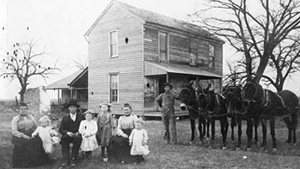
John Neely Bryan was born December 24, 1810 in Fayetteville, Lincoln County, Tennessee to James and Elizabeth Neely Bryan. Bryan lived for a number of years in Tennessee where with his local liberal education, he was able to teach school. When he was a young adult, he studied law and was admitted to the Tennessee bar. At about the age of twenty-three, he moved to Arkansas where he is said to have traded with the Indians. During the next ten years he traveled to Texas at least two times, finally settling near the current site of Dallas around 1840, still in the days of the Republic of Texas. Bryan obtained a headright of 640 acres just on the north of the Trinity River and built a cabin there.
He later met and married the former Margaret Beeman two years later on February 26, 1843. Margaret was also from a family of early pioneers who had settled near White Rock Creek. The couple had six children, four of whom lived to adulthood. In the 1840s, Bryan was instrumental in the founding of Dallas, working with J. P. Dumas to survey and plat the townsite, which he named Dallas. There are a number of theories about the person or persons for whom Dallas is named, including a vice president of the United States. Bryan never completely identified the individual either, so no one knows for certain who it might have been. Bryan is said to have been instrumental in the formation of Dallas County. Once Dallas was named as the county seat, he donated the land upon which the first court house was built. He also operated a ferry that crossed the Trinity River and owned a considerable amount of acreage that would become downtown Dallas.
Bryan is believed to have briefly left Texas for California during the Gold Rush. Another incident is widely reported where Bryan is said to have shot a man for insulting his wife, though the man is said to have recovered. For a few years, he lived with the Creek Indians before leaving again to do more prospecting for gold. Around 1860, it is believed that he returned to Dallas. Bryan served for about one year in Col. Nicholas H. Darnell’s 18th Texas Cavalry before before being discharged due to his age and ill health and returning to Dallas in 1862.
Bryan was active in community affairs for the next fifteen years. At some point his physical and mental health declined and in 1877 he was admitted to the State Lunatic Asylum in Austin where he died later that year. Bryan’s actual burial place is lost to history, but a memorial marker was placed in his honor in Pioneer Cemetery in downtown Dallas.


